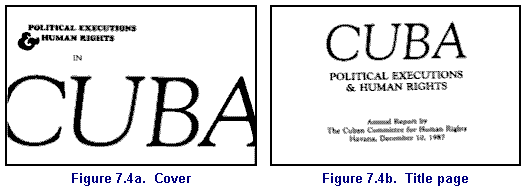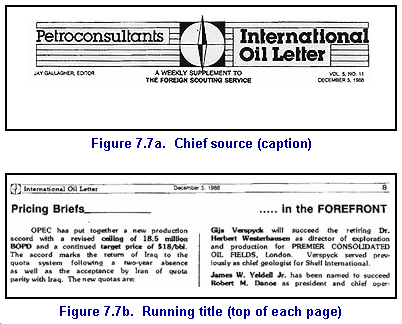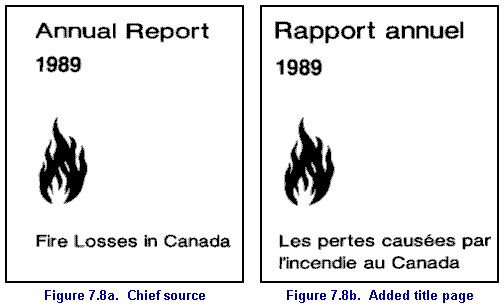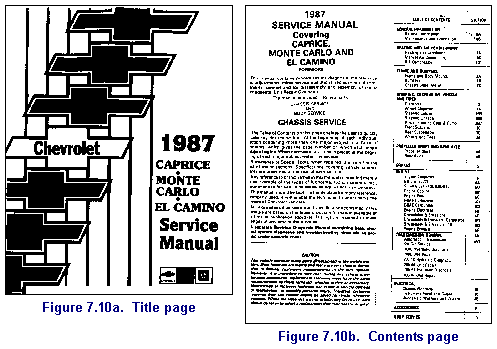Cataloger's Reference Shelf
CONSER Cataloging Manual
7.2. Types of variant titles
7.2.1. Variant titles that are a portion or variation of the title statement as already recorded in field 245
Give access to a portion of the title when a user might consider this portion to be the title proper or when access to the portion will improve the overall retrievability of the record (see LCRI 21.30J ). This category includes variant titles given for:
![]() portions of the title proper
portions of the title proper
![]() section titles
section titles
Consider also giving a 246 field for a varying arrangement of words in the title when the typography or layout leaves the order of the title unclear.
a. Portions of the title proper
Provide a variant title for a portion of the title proper that is typographically prominent and might be construed to be the title proper. Do not make a note because this information is already given in the record. Set the second indicator value to "0." Make an added entry in all cases by setting the first indicator to "3".
|
|
In Figure 7.1., "Federal Aid and Allied Highway Programs" is prominent and is given an added entry.
245 00 $a Tables showing progress of federal aid and allied highway programs. 246 30 $a Federal aid and allied highway programs
|
|
In Figure 7.2., an added entry is given for "Fire losses in Canada" because this might be thought to be the title. It also provides a more searchable access point.
245 00 $a Annual report ..., fire losses in Canada. 246 30 $a Fire losses in Canada |
|
For titles that contain an alternative title, such as The Emerald, or Miscellany of literature, give a 246 field for the alternative title (Miscellany of literature) and also for the portion of the title proper that precedes the word "or" (Emerald) when this portion consists of less than five words. This provides the necessary access for a user who might not think to include the word "or" and the alternative title in the search.
245 14 $a The emerald, or, Miscellany of literature.
246 30 $a Miscellany of literature
246 20 $a Emerald
When the title proper consists of a common title and section title, give the section title in a 246 field when the title is distinctive and will provide useful access. In general, do not give access to section titles that are very general, such as names of cities, states, or countries or general words such as "supplement."
|
|
245 00 $a Journal of physics. $n D, $p Applied physics. 246 30 $a Applied physics
|
If the issuing body appears before the title and has been transcribed as a statement of responsibility and the user might consider the title to begin with the issuing body due to the typography and spacing, field 246 may be given for the body and title (AACR2 12.1B3, LCRI 21.30J ). (See also CCM 6.1.5.)
245 00 $a Annual report / $c Prince Edward Island Energy Corporation.
246 3# $a Prince Edward Island Energy Corporation annual report
A similar situation occurs when a word or phrase appears above the title that has been rejected from the title proper (LCRI 12.1B3) or when introductory words are omitted from the title (AACR2 1.1B1). To provide access to the title beginning with these words, give an "At head of title" 500 note and a 246 field combining the word or phrase with the title proper. If the phrase can stand on its own, a 246 field with a subfield $i is sufficient.
245 00 $a Business review.
246 3# $a International business review
500 ## $a At head of title: International.
245 00 $a Bulletin of atomic scientists.
246 1# $i At head of title: $a Science and public affairs
Give an added entry for parallel titles appearing in the title statement or in a note, supplying a separate 246 field for each with second indicator value set to "1". (See also CCM 6.4. and 6.7.2.)
245 00 $a Revista interamericana de bibliografía = $b Review of inter-American bibliography.
246 1# $i English title, 1952- given as: $a Inter-American review of bibliography
246 31 $a Review of inter-American bibliography
In most cases, do not give a 246 field variant title for other title information. When the title, as given on the piece, consists of an acronym or initialism and the full form, however, give an added entry for the acronym or initialism recorded in field 245 $b. See also CCM 6.3.5. for additional types of other title information for which an added entry may be given.
245 00 $a Advances in nursing science : $b ANS.
246 30 $a ANS
g. Corrections to the title proper
If the title as it appears on the piece contains an incorrect word or phrase that has been corrected in the title statement, give an added entry for the title as it appears on the piece (AACR2 12.1B1, LCRI 21.30J ). (See also CCM 6.1.3.)
245 00 $a African seminar series.
246 1# $i Issue for 1986 has title: $a African semminar series
7.2.2. Variant titles that appear on the piece in a prominent place other than the chief source
Serial publishers are often creative with their titles. Sometimes the title as found on the chief source appears in different forms elsewhere in the serial. Since it is possible that the serial might be known or cited by the variant form, a note and added entry are generally given (AACR2 21.30J2).
Variant titles for printed serials are generally those for: cover title, caption title, spine title, running title, added title page title, and "other" title. In MARC 21 records, these are expressed by setting the appropriate second indicator value in field 246 . For non-print serials, other sources are specified such as: title on label, and so forth. In these cases, the desired terminology must be explicitly input, followed by the title, using 246 1# and subfield $i.
245 00 $a Journal of visual literacy.
246 17 $a JVL
[field 246 generates an added entry and the note: Running title: JVL,]
245 00 $a Serial publications in the British Museum (Natural History) library, on microfiche $h [microform].
246 1# $i Title on eye-readable header: $a BMNH serials
[field 246 generates an added entry and the note: Title on eye-readable header: BMNH serials.]
It is not necessary to provide a 246 field for every variant title that appears on the piece. Note the following guidelines given in LCRI 21.30J : (italics supplied)
Make added entries more or less automatically for cover titles, parallel titles, and added title page titles when they are significantly different from the title proper (cf. 21.2C). Be more restrictive about caption titles, half titles, running titles, and other title information; added entries for these are generally made only if the following is true ... the title is given such prominence by typography or by other means that it is reasonable to assume that the publication may be known by it or that persons examining the item might think that it is the main title of the publication.
|
In general, give a variant title when: 1) it differs substantially from the title proper 2) it contributes to the identification of the serial 3) it provides meaningful access (e.g., it provides a useful search in the online database) 4) it is located prominently and likely to be searched as the title |
When the same variant form appears in two or more sources, choose the source that is most prominent or most likely to be noticed, for example, the cover rather than the running title.
a. Cover title (field 246 2nd indicator "4")
A title printed on the cover of an item as issued ( FN 2). Give a variant title for a title given on the original cover of the serial as supplied by the publisher that differs in a significant way from the title given on the chief source.
Note: In order to use "cover title" (246 14) the cover must not be the source of the title proper. Do not confuse the variant form "Cover title:" with the "Title from cover" note that is used when the cover is selected as the chief source because there is no title page.

The titles on the cover and on the title page differ significantly warranting an added entry. In this example, additional added entries are also given because of the ampersand.
245 00 $a Cuba, political executions & human rights.
246 3# $a Cuba, political executions and human rights
246 14 $a Political executions & human rights in Cuba
246 3# $a Political executions and human rights in Cuba
b. Caption title (field 246 2nd indicator "6")
A title given at the beginning of the first page of the text ( FN 2). The table of contents and editorial pages are not considered to be text; therefore, a variant title appearing on these pages is coded as " other title" (see below) rather than "caption title." Do not confuse the variant form "caption title" with the "Title from caption" note that is used when there is no cover or title page and the caption is the chief source.
|
|
245 00 $a Report for ... / $c The University of Hong Kong. 246 16 $a Report of the working of the University of Hong Kong for ...
|
c. Spine title (field 246 2nd indicator "8")
A title appearing on the spine of an item ( FN 2). As with the cover title, the spine title must be taken from the publisher’s original cover.
|
245 00 $a Chevrolet Caprice, Monte Carlo, El Camino service manual. 246 30 $a Caprice, Monte Carlo, El Camino service manual 246 18 $a Service manual, Caprice, Monte Carlo, El Camino
|
|
d. Running title (field 246 2nd indicator "7")
A title, or abbreviated title, that is repeated at the head or foot of each page or leaf ( FN 2). Both left and right pages may be considered as one source for the running title.
Note: While LCRI 21.30J instructs you to be more restrictive in giving access for a running title, this may be an important access point for serials. A user might have an offprint or photocopy of an article in which the name of the serial occurs only at the foot of the page and might search for the serial using this title.

245 00 $a Petroconsultants international oil letter.
246 17 $a International oil letter
In this case, the 246 field could have also been tagged as "30" for portion of title, since this part of the title appears separately from the first word.
e. Added title page title (field 246 2nd indicator "5")
A title appearing on a title page that has not been chosen as the chief source. This situation occurs frequently in bilingual serials where two title pages face each other or are found at either end of the publication. In some cases the title pages and text may be inverted. Do not treat the title on a series title page as an added title page title (see Module 12).

245 00 $a Annual report ..., fire losses in Canada.
246 30 $a Fire losses in Canada
246 15 $a Rapport annuel ..., les pertes causées par l'incendie au Canada
246 30 $a Pertes causées par l'incendie au Canada
Note that additional added entries are given for the portions of title on the chief source and on the added title page.
f. Distinctive title (field 246 2nd indicator "2")
A title that appears in addition to the title proper, that is unique to an issue, and that is often related to the topic or theme of that issue. All or some issues of the serial may have distinctive titles. Distinctive titles are often found on annual reports and conference publications.
In most cases, do not give distinctive titles in 246 fields because it is impractical to add a new title added entry each time a new issue is received. Instead, add a note such as "Each issue also has a distinctive title" or "Some issues have distinctive titles." Do not use this note for monographic series, because monographic series always have distinctive titles. Consider recording distinctive titles in field 246 when the number of titles is known to be limited (e.g., complete run is in hand and only two issues have a distinctive title) and when these titles are considered important for access. Do not treat as a distinctive title an additional title that appears on each issue and is the same from issue to issue; instead, treat as other title information, at head of title, etc.
|
|
In Figure 7.9., "Spirituality and healing" is a distinctive title for this issue. A general note is given rather than a specific added entry. 245 00 $a Holistic nursing practice. 500 ## $a Each issue also has a distinctive title.
|
g. Other title (field 246 2nd indicator "3")
A title appearing on a source that is not covered by those listed above. The general item "other title" is most often used for a variant title appearing in the masthead or on the contents or editorial page. Consider titles appearing on a page that precedes the title page (a "half-title") or a binder’s title (i.e., binding is not that of the publisher) to be "other titles." Include also in this category cover titles that are not the chief source and are found in an inverted format on bilingual serials. Do not consider titles found on the chief source to be "other titles"; these titles are recorded as other title information, in an "At head of title" or general note, or are not recorded at all.

245 00 $a Chevrolet Caprice, Monte Carlo, El Camino service manual.
246 30 $a Caprice, Monte Carlo, El Camino service manual
246 13 $a Service manual covering Caprice, Monte Carlo and El Camino
7.2.3. Variant titles that provide access to different forms of words in titles given in field 245 or 246
If the title proper or a variant title contains words that the user might search in a different form, give a 246 field using the variant form. Such access may be given of compound words, spelled out forms of symbols, such as "and" for "&", and spelled out numbers, etc. Give an added entry, in most cases, but do not give a note when this form of the title does not appear elsewhere on the piece (246 3#). LCRI 21.30J lists the situations in which added entries may be given. While you do not have to give every possible added entry, the LCRI says "when in doubt, be liberal in assigning additional title added entries."
Give added entries when the following situations occur within the first five words of the title (excluding initial articles).
Give word(s) spelled out.
245 00 $a St. Louis directory of ...
246 3# $a Saint Louis directory of ...
Give as "and" (or equivalent in another language).
245 00 $a Catalogue & index.
246 3# $a Catalogue and index
c. Compound and hyphenate words
Give as one word, two words, or both, as appropriate. (Note: This is generally needed only for online searching. Systems vary in their treatment of hyphenated words. For example, OCLC treats a hyphenated word as one word in a truncated search and as two words in a title browse.)
245 00 $a Forest products year-book. [made up example]
246 2# $a Forest products year book
246 2# $a Forest products yearbook
d. Letters and initialisms (including acronyms)
If an initialism contains punctuation or spaces between the letters, give a variant title omitting the punctuation or spaces; do not make an added entry to add spaces or punctuation.
245 00 $a A.-G. Chemie ...
246 3# $a AG Chemie
245 00 $a AADE editor's journal.
[no 246 for A.A.D.E. editor's journal]
The spelled out form of the initialism or acronym may be given when this can be determined. Note: This form of access is not called for in LCRI 21.30J and is optional. It is most useful when the initialism is not well known or might be misinterpreted and the spelled out form is not given elsewhere in the record ( FN 3). Give this type of access only when considered useful, not routinely.
245 00 $a CD computing news.
246 2# $a Compact disc computing news
245 00 $a CD rateline.
246 2# $a Certificate of deposit rateline
|
In cases where a number has been given as part of the title proper, give an added entry for the spelled-out form, and for the Arabic numeral if the number was given as a Roman numeral. (Figure 7.11.)
245 00 $a 2 AM magazine. 246 3# $a Two AM magazine |
|
If a sign or symbol can be given in the title proper (e.g., +), give an added entry for the word represented by the sign or symbol (e.g., plus) in the language of the title proper. For signs and symbols that cannot be represented, see CCM 6.1.3.b.
245 00 $a Denturo +.
246 3# $a Denturo y
In cases where a serial is conventionally known by a variant title that does not appear on the piece, consider providing an added entry for the title together with a note (AACR2 12.7B4.1).
245 00 $a Library of Congress information bulletin.
246 1# $i Commonly known as: $a LCIB
When a title exemplifies several of the conditions that would warrant an added entry according to LCRI 21.30J , determine which will be most useful and try to combine when possible.
245 00 $a Year-book & calendar of events. [made up example]
246 3# $a Yearbook and calendar of events
7.2.4. Variant titles that are minor title changes
AACR2 21.2C2b lists the categories of minor changes to the title proper. Once a change is determined to be minor, decide how to note the change. Some form of note should always be given, whether it be explicit (e.g., "Some issues have title: ..." ( 246 )) or general (e.g. "Title varies slightly" ( 500 )). Consider the value of providing the additional access when deciding whether to give a 246 field for the minor change. If the change affects searching or if it is thought that another cataloger might consider the change to be major, prefer giving the change explicitly to show that you have determined it to be minor. When an added entry (246) is needed, the minor change is given explicitly in the note. If no added entry is necessary, a "Title varies slightly" note may suffice.
245 10 $a Annual report / $c California Military Institute. [made up example]
246 1# $i Some issues have title: $a Annual report of the California Military Institute
245 00 $a Freeport daily journal.
246 1# $i Alternate issues published with title: $a Chicago daily telegraph
but ...
In cataloging record:
245 00 $a Water quality data summary statistics.
On later issue: Water quality data summary statistics for the year 1990
Added to record:
500 ## $a Title varies slightly.
For more information on minor changes and further examples, see Module 16.
In some cases, there may already be a 246 field present, created under the provisions of LCRI 21.30J (see CCM 7.2.3. above). For example, the original title contained an ampersand and a 246 was given using the spelled out form "and". In later issues the ampersand is replaced on the piece by "and". In this case, a 500 "Title varies slightly" note will suffice.
If the changes occur after the first five words in a long title and have little significance, prefer the "Title varies slightly" note.
See also:
Module 7. Variant Titles and Title Added Entries (Fields 246, 245 and 730/740/700-711)